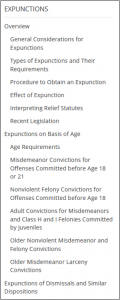 I am happy to announce the completion of the 2020 Edition of my online guide to expunctions and other relief from a criminal conviction in North Carolina. It took me a while to dissect and incorporate all the changes into the previous, 2018 online edition. (It would have taken far longer to update the guide without the patient and painstaking work of Owen Dubose of the School’s publications division.) If I missed anything or got anything wrong, please let me know. Here is what you’ll find in the new edition.
I am happy to announce the completion of the 2020 Edition of my online guide to expunctions and other relief from a criminal conviction in North Carolina. It took me a while to dissect and incorporate all the changes into the previous, 2018 online edition. (It would have taken far longer to update the guide without the patient and painstaking work of Owen Dubose of the School’s publications division.) If I missed anything or got anything wrong, please let me know. Here is what you’ll find in the new edition.
 First and foremost the guide includes new and expanded sections on the principal forms of relief addressed by the 2020 Second Chance Act: expunctions of adult convictions of juveniles under G.S. 15A-145.8A; dismissals and acquittals under G.S. 15A-146; and convictions of nonviolent misdemeanors and felonies under G.S. 15A-145.5. I recommend you read the provisions closely. The interlocking conditions for relief, particularly in G.S. 15A-145.5, create some results you may not anticipate, some favorable to petitioners, some not. To find a discussion of each type of expunction and other form of relief, such as certificates of relief and termination of sex offender registration, click on the applicable link in the menu along the right side of the guide (or at the bottom if you’re using a smartphone). You can see an excerpt of the menu in this blog post.
First and foremost the guide includes new and expanded sections on the principal forms of relief addressed by the 2020 Second Chance Act: expunctions of adult convictions of juveniles under G.S. 15A-145.8A; dismissals and acquittals under G.S. 15A-146; and convictions of nonviolent misdemeanors and felonies under G.S. 15A-145.5. I recommend you read the provisions closely. The interlocking conditions for relief, particularly in G.S. 15A-145.5, create some results you may not anticipate, some favorable to petitioners, some not. To find a discussion of each type of expunction and other form of relief, such as certificates of relief and termination of sex offender registration, click on the applicable link in the menu along the right side of the guide (or at the bottom if you’re using a smartphone). You can see an excerpt of the menu in this blog post.
The guide also includes an expanded discussion of the procedure to obtain an expunction and its effect. Recent appellate decisions, usually few and far between in this area of law, have clarified that expunctions in North Carolina are part of criminal proceedings. The expanded procedure section of the guide discusses the impact of those decisions on appellate review of trial level decisions as well as other procedural issues, such as hearing provisions and grounds for filing a subsequent petition if the trial court initially denies expunction.
The Second Chance Act modified the effect of an expunction, primarily in subsequent criminal proceedings. Along with expanded opportunities for relief, the Second Chance Act expanded the purposes for which prosecutors can use expunged convictions if the person commits a new offense, discussed in the section of the guide on effect of an expunction. Readers should closely review the provisions to determine the specific uses permitted and the extent to which the provisions may apply retroactively to expunction petitions granted or filed before the effective date of the legislation, December 1, 2020. See generally State v. Ramseur, 374 N.C. 658, 677 (2020) (holding that retroactive application of repeal of Racial Justice Act to pending motion for relief violated ex post facto principles).
The guide includes a keyword search feature (in addition to the navigation menu) to help you find your way through this dense, technical area of law. It also includes live links to the governing statutes, links to current forms from the Administrative Office of the Courts, and a link (at the bottom of the menu in the guide) to a collection of frequently asked questions. I hope you find the guide a useful resource.